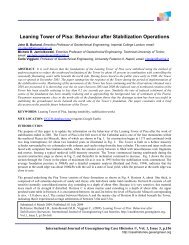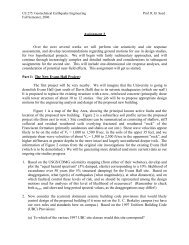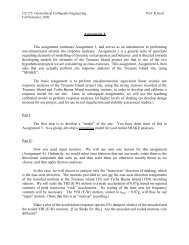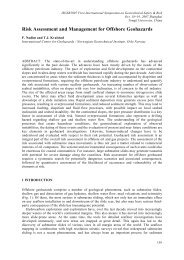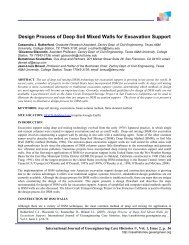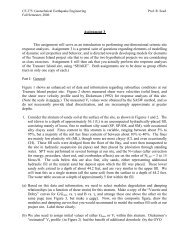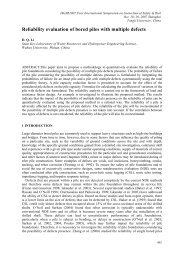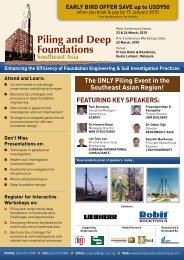Homework 1 (pdf) - Geotechnical Earthquake Engineering
Homework 1 (pdf) - Geotechnical Earthquake Engineering
Homework 1 (pdf) - Geotechnical Earthquake Engineering
Create successful ePaper yourself
Turn your PDF publications into a flip-book with our unique Google optimized e-Paper software.
for the city of Charleston (in the Charleston seismic region). These are the two principal<br />
“eastern U.S.” seismic zones. Plot both spectra on the same plot.<br />
(d) Now consider Charleston a bit more closely. Plot approximate Equal Hazard Spectra for<br />
Charleston for both the 10% probability of exceedance in 50 years (~475 year return<br />
interval) level, and the 2% probability of exceedance in 50 years (~2,500 year return<br />
interval) level [Plot these both on the same figure.] Using the 1996 “deaggregation”<br />
option, deaggregate these spectra by Magnitude (M) and Distance (R). Note that the<br />
deaggregation will be different at shorter and longer periods, so you will want to<br />
deaggregate for PGA and for the various spectral ordinates separately.<br />
• Using your Equal Hazard Spectrum for 10% in 50 years, and the<br />
deaggregation, recommend the approximate initial characteristics (a max , M w<br />
and R) for a “design basis” earthquake for use in design of an 2 to 3-story<br />
apartment complex and shopping center in Charleston.<br />
• Using your Equal Hazard Spectrum for 2% in 50 years, and the deaggregation,<br />
recommend the approximate initial characteristics characteristics (a max, M w<br />
and R) for a “design basis” earthquake for use in design of a major earth dam<br />
(with a crest height of approximately 350 feet, and a predominant period of<br />
about 0.8 seconds) near Charleston.<br />
Part II:<br />
3. Find the location where you live (while attending U. C. Berkeley.) Again, find the PGA, and<br />
the S A values for T = 0.2, 0.3 0.5 and 1.0 seconds, and plot the Equal Hazard Spectrum (5%<br />
damped, elastic) for a probability of exceedance of 10% in 50 years (the presumed UBC<br />
building code level.) On the same figure, plot the actual response spectrum from the current<br />
UBC for Site Class C conditions. (Don’t forget to apply the near field factors if appropriate.)<br />
Does this worry you? Remember, if your building is more then about ten years old, it was<br />
probably designed for even lesser levels of shaking.<br />
Part III:<br />
Now, on your own volition, and despite a rigorous schedule of competing priorities and<br />
conflicting assignments from other courses, access another web site (still under construction)<br />
sponsored by CDMG at http://www.consrv.ca.gov/cgs/, and explore a bit. This site is dedicated<br />
more locally to California, and presents similar information to that presented by the USGS site,<br />
but it is not yet as well along.<br />
4. Repeat the First part of Question #3 above. Is the strong shaking hazard mapping of this site<br />
the same (same basis, and same values) as the USGS site? (Don’t spend a long time on this<br />
one….just make a few quick checks.)



